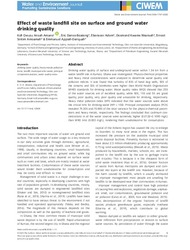Effect of waste landfill site on surface and ground water drinking quality
Danso‐Boateng, Eric
Adom, Ebenezer
Kwame Nkansah, Desmond
Amoamah, Ernest Sintim
Appiah‐Danquah, Emmanuel
DOI: https://doi.org/10.1111/wej.12664
Persistent URL: http://resolver.sub.uni-goettingen.de/purl?gldocs-11858/8447
Persistent URL: http://resolver.sub.uni-goettingen.de/purl?gldocs-11858/8447
Amano, Kofi Owusu Ansah; Danso‐Boateng, Eric; Adom, Ebenezer; Kwame Nkansah, Desmond; Amoamah, Ernest Sintim; Appiah‐Danquah, Emmanuel, 2020: Effect of waste landfill site on surface and ground water drinking quality. In: Water and Environment Journal, DOI: 10.1111/wej.12664.
 |
Dokument öffnen: |
Drinking water quality of surface and underground water within 1.34 km from a waste landfill site in Kumasi, Ghana was investigated. Physico‐chemical properties and heavy metal concentrations were analysed to determine water quality and pollution indices. It was found that turbidity of 83% of hand dug wells, 50% of the streams and 33% of boreholes were higher than World Health Organisation (WHO) standards for drinking water. Water quality index (WQI) showed that 25% of the water sources are of excellent quality, while 50%, 15% and 5% are good quality, poor quality, very poor quality and unsuitable for drinking, respectively. Heavy metal pollution index (HPI) indicated that the water sources were above the critical limit for drinking water (HPI > 100). Principal component analysis (PCA) revealed 75.30% and 70.88% of the total variance for the physico‐chemical parameters and heavy metals, respectively. The findings concluded that cadmium concentrations in all the water sources were extremely higher (0.0122–0.1090 mg/L) than WHO limit (0.003 mg/L), rendering them unwholesome for consumption.
Statistik:
ZugriffsstatistikSammlung:
Schlagworte:
drinking water qualityheavy metals pollution index
landfill
municipal solid waste
principal component analysis
water quality index
This is an open access article under the terms of the Creative Commons Attribution License, which permits use, distribution and reproduction in any medium, provided the original work is properly cited.

